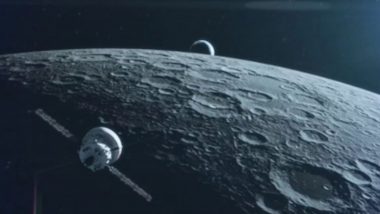Tokyo, April 25: Japanese lunar exploration company ispace lost communication at the last minute during a planned touchdown on the surface of the Moon on Tuesday. "We assume that we could not complete the landing on the lunar surface," said Founder and CEO Takeshi Hakamad.
After five months journeying through space, the HAKUTO-R Mission 1 Lunar Lander was scheduled to make a historic touchdown at 16:40 UTC (10:10 p.m. IST) in the Atlas Crater, which is in the northeastern sector of the Moon. However, the signal from the lander cut out at the last minute. Japan’s Historic Moon Mission: Private Japanese Spacecraft From Ispace To Make Lunar Touchdown on April 25.
Watch Video: Private Japanese Lander Loses Communication During Touchdown on Moon
BREAKING: Japan's ispace says Moon landing may have failed, no contact with spacecraft pic.twitter.com/afscUiPSJ9
— BNO News Live (@BNODesk) April 25, 2023
So far, no privately operated spacecraft has ever landed softly on the moon, besides those operated by national space agencies of the US (NASA), Russia (Roscosmos) and China (China National Space Administration). Japanese Lunar Exploration Company Ispace Successfully Launches Lander on the Lunar Orbit.
In 2019, two attempted lunar landings, India's Vikram lander and Israeli nonprofit SpaceIL's Beresheet had both crashed. In those landing attempts, the trajectory and speed data went awry before the signals were lost.
However, "our M-1 lander was able to communicate till the last minute, which is a great achievement", Hakamad said. "We are very proud we have already achieved many things during the M-1 lander. The feedback will be applied for the upcoming Mission-2, and Mission-3 targeted to launch in 2024 and 2025, respectively.
"We will continue to make efforts for the future missions," he said. The M-1 lander, about 7 feet tall, carried small rovers and payloads for a number of government agencies and companies - including from the US, Canada, Japan and the UAE.
These include: the Rashid lunar rover from the Mohammed Bin Rashid Space Center in Dubai; a two-wheeled transformable lunar robot from JAXA, the Japanese space agency; a test module for a solid-state battery from NGK Spark Plug Company; an artificial intelligence flight computer; and 360-degree cameras from Canadensys Aerospace, the company said.
The M1 lander began its journey to the Moon on December 11, 2022, with the launch of a SpaceX Falcon 9 rocket from Cape Canaveral, Florida.Following Mission 1, ispace plans two other robotic flights to the surface of the Moon. Mission 2 and Mission 3 are targeted to launch in 2024 and 2025, respectively, and also will contribute to NASA's Artemis Programme.
Mission 3's lander will carry payloads to the surface and also deploy two communications satellites in lunar orbit, ispace said. The company was founded by Hakamad, more than a decade ago. ispace originated as a team competing for the Google Lunar Xprize under the name Hakuto - after a mythological Japanese white rabbit.
After the Xprize competition was cancelled, ispace pivoted and expanded its goals, with CEO Hakamada aiming to create "an economically viable ecosystem" around the moon, he said in a recent interview.
(The above story first appeared on LatestLY on Apr 25, 2023 11:28 PM IST. For more news and updates on politics, world, sports, entertainment and lifestyle, log on to our website latestly.com).













 Quickly
Quickly











